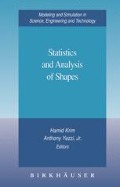Abstract
Generalized weak perspective is a common camera model describing the geometric projection for many common scenarios (e.g., 3D to 2D). This chapter describes a metric constructed for comparing (matching) configurations of object features to configurations of image features that is invariant to any affine transformation of the object or image. The natural descriptors are the Plücker coordinates because the Grassmann manifold is the natural shape space for invariance of point features under affine transformations in either the object or image. The objectimage equations detail the relation between the object descriptors and the image descriptors, and an algorithm is provided to compute the distances for all cases.
Access this chapter
Tax calculation will be finalised at checkout
Purchases are for personal use only
Preview
Unable to display preview. Download preview PDF.
References
T. Arias, A. Edelman, and S. Smith. The geometry of algorithms and orthog-onality constraints. SIAM Journal of Matrix Analysis and Applications, 20: 303–353, 1998.
G. Arnold, P. Stiller, and K. Sturtz. Object-image metrics for generalized weak perspective projection. Technical report, Air Force Research Laboratory, 2005.
G. Arnold and K. Sturtz. Object-image metrics and metric duality. Technical report, Air Force Research Laboratory, 2005.
G. Arnold, K. Sturtz, and V. Velten. Similarity metrics for ATR. In Proc. of Defense Applications of Signal Processing (DASP-01), Adelaide, AU, June 2001. AFOSR.
R. Basri and D. Weinshall. Distance metric between 3D models and 2D images for recognition and classification. A.I. Memo 1373, MIT, July 1992.
I. Csiszár. Why least squares and maximum entropy? an axiomatic approach to inference for linear inverse problems. The Annals of Statistics, 19(4):2032–2066, 1991.
I.L. Dryden and K.V. Mardia. Statistical Shape Analysis. John Wiley & Sons, 1998.
P. Griffiths and J. Harris. Principles of Algebraic Geometry. Wiley and Sons, 1978.
W.E. L. Grimson, D.P. Huttenlocher, and T. Alter. Recognizing 3D objects from 2D images: An error analysis. A.I. Memo 1362, MIT, July 1992.
W.V.D. Hodge and D. Pedoe. Methods of Algebraic Geometry. Number 1,2, and 3 in Mathematical Library Series. Cambridge University Press, Cambridge, 1994.
D.W. Jacobs. Matching 3-D models to 2-D images. AI Lab Technical Report 1416, MIT, Sept. 1992.
A. Johnson. Spin-Images: A Representation for 3-D Surface Matching. Ph.D. thesis, Robotics Institute, Carnegie Mellon University, Pittsburgh, PAAugust 1997.
I. Kemelmacher and R. Basri. Indexing with unknown illumination and pose. In Proc. IEEE Conf. on Computer Vision and Pattern Recognition (CVPR), volume 1, pages 909–916, San Diego, CA, June 2005. IEEE, Computer Society.
S.R. Lele and J.T. Richtsmeier. An Invariant Approach to Statistical Analysis of Shape. Chapman & Hall/CRC, 2001.
D. Mumford. Mathematical theories of shape: Do they model perception? In B. C. Vemuri, editor, Proceedings SPIE, Geometric Methods in Computer Vi-sion, volume 1570, pages 2–10, Bellingham, WA, July 1991. SPIE-The Int’l Society for Optical Engineering.
M. Ray. Model-based 3D Object Recognition Using Invariants. Ph.D. thesis, University of Maryland, College Park, 2000.
S. Santini and R. Jain. Similarity measures. IEEE Trans. on Pattern Analysis and Machine Intelligence, 21(9):871–883, Sept. 1999.
A. Shashua. Algebraic functions for recognition. IEEE Trans. on Pattern Analysis and Machine Intelligence, 17(8):779–789, Aug. 1995.
C.G. Small. The Statistical Theory of Shape. Springer-Verlag New York, Incorporated, 1996.
P.F. Stiller. General approaches to recognizing geometric configurations from a single view. In Proceedings SPIE Int’l Conf., Vision Geometry VI, volume 3168, pages 262–273, Bellingham, WA, July 1997. SPIE-The Int’l Society for Optical Engineering.
P.F. Stiller. Object recognition from a global geometric perspective: invariants and metrics. In Proceedings SPIE Int’l Conf., Vision Geometry XI, volume 4794, pages 71–80, Seattle, WA, July 2002. SPIE-The Int’l Society for Optical Engineering.
P.F. Stiller. Object/image relations and vision metrics I. In M. Schmalz, editor, Symposium on Optical Science and Technology, Mathematics of Data/Image Coding, Compression, and Encryption VI, with Applications, volume 5208, pages 165–178, San Diego, CA, Aug. 2003. SPIE-The Int’l Society for Optical Engineering.
P.F. Stiller. Vision metrics and object/image relations II: Discrimination met-rics and object/image duality. In Proceedings SPIE Int’l Conf., Electronic Imag-ing, Vision Geometry XII, volume 5300, pages 74–85, San Jose, CA, Jan. 2004. SPIE-The Int’l Society for Optical Engineering.
P.F. Stiller, C.A. Asmuth, and C.S. Wan. Invariants, indexing, and single view recognition. In Proc. ARPA Image Understanding Workshop, pages 1432–1428, Monterrey, CA, November 1994.
P.F. Stiller, C.A. Asmuth, and C.S. Wan. Single view recognition —the perspective case. In Proceedings SPIE Int’l Conf., Vision Geometry V, volume 2826, pages 226–235, Bellingham, WA, Aug. 1996. SPIE-The Int’l Society for Optical Engineering.
M.A. Stuff. Three-dimensional analysis of moving target radar signals: Meth-ods and implications for ATR and feature aided tracking. In E. Zelnio, editor, Proceedings SPIE Int’l Conf., Algorithms for Synthetic Aperture Radar Im-agery VI, Bellingham, WA, April 1999. SPIE-The Int’l Society for Optical Engineering.
M.A. Stuff. Three dimensional invariants of moving targets. In E. Zelnio, editor, Proceedings SPIE Int’l Conf., Algorithms for Synthetic Aperture Radar Imagery VII, Bellingham, WA, April 2000. SPIE-The Int’l Society for Optical Engineering.
G. Wallis and E.T. Rolls. Invariant face and object recognition in the visual system. Progress in Neurobiology, 51:167–194, 1997.
I. Weiss. Model-based recognition of 3D objects from one view. In Proc. DARPA Image Understanding Workshop, pages 641–652, Monterey, CA, No-vember 1998. Morgan Kauffman.
E.W. Weisstein. The CRC Concise Encyclopedia of Mathematics.CRC Press, 2nd edition, 2002. see http://www.mathworld.com.
Author information
Authors and Affiliations
Editor information
Editors and Affiliations
Rights and permissions
Copyright information
© 2006 Birkhäuser Boston
About this chapter
Cite this chapter
Arnold, G., Stiller, P.F., Sturtz, K. (2006). Object-Image Metrics for Generalized Weak Perspective Projection. In: Krim, H., Yezzi, A. (eds) Statistics and Analysis of Shapes. Modeling and Simulation in Science, Engineering and Technology. Birkhäuser Boston. https://doi.org/10.1007/0-8176-4481-4_10
Download citation
DOI: https://doi.org/10.1007/0-8176-4481-4_10
Publisher Name: Birkhäuser Boston
Print ISBN: 978-0-8176-4376-8
Online ISBN: 978-0-8176-4481-9
eBook Packages: Mathematics and StatisticsMathematics and Statistics (R0)

